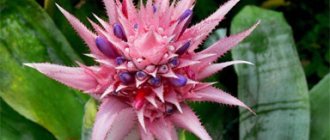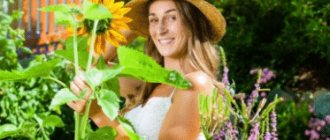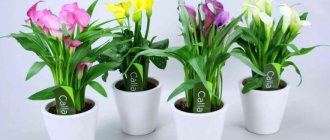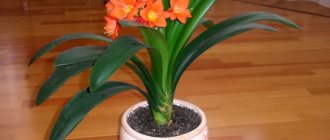Aeschynanthus is a beautiful tropical plant native to Asia, which in natural conditions is attached by its roots to the trunks and branches of massive trees for support. Its Latin name, Aeschynanthus, comes from the ancient Greek words for “distorted” and “flower,” probably due to its orange-red, yellowish, burgundy buds that arch to the side. And it is precisely because of their color that the affectionate names of aeschynanthus have taken root among people - “fudge” or “bird of paradise” flower.
Depending on the species, the exotic plant takes on a liana-like or shrub-like form; its branches can reach 30-90 centimeters. They are decorated with racemose inflorescences and dense, rich green leaves, which are highly valued by florists when composing modern, stylish bouquets. However, fondant is still not often seen among home flower lovers.
.Eschinatus_nature
Description of decorative aeschynanthus
Residents of Asia, where this bright bush can often be seen, ironically call it a “lipstick flower.” The explanation for this nickname lies in the appearance of the bracts and the purple petals visible from them.
A description of its distinctive features will help to form a general idea of the decorative aeschynanthus. This plant is one of the perennial evergreen subshrubs, which with considerable effort is adapted to home conditions. The climbing stems are decorated with fleshy bright green leaves located opposite each other on short cuttings. In size, the leaf plates barely reach 3 cm in width and up to 10 cm in length.
An adult plant is not large in size, since its height ranges from 40 to 70 cm. Due to the “creeping” branches, hanging pots or cache-pots are ideal for it, which will emphasize all the beauty and grace of the bush.
The indoor ornamental plant Aeschynanthus simply stuns with cascades of orange or purple flowers, crowning the ends of its climbing stems. Outwardly, they resemble curved tubes with a velvety surface. The inflorescence contains from 5 to 10 bright flowers and delights with its long flowering - from June to the end of September. It is precisely because of the attractiveness and charm of this flowering bush that flower growers try to satisfy all its “whims” and requirements as much as possible.
To be convinced of what has been said, take a look at the photo of a bright indoor aeschynanthus, which will not leave anyone indifferent, captivating with its beauty and rich palette of purple-scarlet colors:
Usage
Houseplants Aeschynanthus are grown for its ornamental beauty in hanging baskets or pots, displaying long trailing stems with dark green foliage and topped with clusters of exotic flowers and buds in striking contrast.
Ideal as indoor plants, as well as for a winter garden or greenhouse. Suitable for hanging baskets, pots to best display their beautiful cascading stems and attractive flowers, or in containers placed on a pedestal or windowsill.
A vine-like plant that can be trained to climb fences and frames, or grown on the ground, or allowed to crawl along moss-covered rock surfaces. The plant can be kept on a windowsill in a bathroom or kitchen when there is high humidity.
Types and varieties of Eschynanthus: description and photos of varieties at flowering time
To date, more than 80 species of liana-like aeschynanthus have been cultivated, despite the difficulties in breeding and growing this elegant representative of the Gesneriev family. However, in specialized stores selling indoor plants, only a few of its most established varieties are found.
So, you can buy:
Aeschynanthus speciosus (orange-red)
Aeschynanthus hiltiebrandtii (red)
Aeschynanthus tricolor (brown-red)
Also various attractive hybrids:
Beautiful (speciosus) is the most famous type of decorative aeschynanthus.
When looking at the photo with his image, the reason for such a “praiseful” name becomes clear:
Chic external parameters make it an excellent decoration for any interior. The curly flexible branches of the flower are quite long - about half a meter. In an adult bush, they begin to become a little coarser at the base, becoming covered with woody bark. The leaves are densely “strung” on oval-shaped shoots and a juicy olive color. During flowering, this liana-like subshrub is decorated with amazing inflorescences, in which 8-10 tubular flowers of orange-red color are connected into a delightful bouquet.
Close in appearance and name is another charming variety of climbing aeschynanthus with an equally intriguing name - beautiful (pulcher). The main difference between this species and its predecessor is the smaller size of both the foliage and the inflorescences themselves. The range of shades in which the flowers are “painted” covers brighter red and fiery tones.
The Lobbianus aeschynanthus (lobbianus) stands out among its relatives for its exquisite flowering. This species, with its bright red inflorescences, fills the interior of the room with a pleasant exotic atmosphere and surprises with a charming play of colors. Thickly mixed small, deep green leaves add to the overall appeal of this homemade "beauty." Flowering duration is about 3-4 months annually.
Marble (marmoratus) type of indoor aeschynanthus, the photo of which justifies its name, is a bright decorative representative of the Gesneriev family:
Its foliage plates are distinguished by a glossy surface and green and yellow abstract patterns that are very similar to marble. It is the foliage of this plant that is considered the main advantage and decoration, since small green flowers with miniature brown spots are not particularly attractive.
Aeschynanthus Hildebrandtii is a beautiful home flower with a thick, juicy green leafy crown, among which one can see sophisticated curved inflorescences of a noble burgundy color. This species is less demanding of its habitat, which explains its popularity among gardeners.
Twister is a “curly” variety of exotic aeschynanthus, whose photo will confirm the harmonious combination of emerald glossy leaves with ruby flowers.
Curvature - this feature is characteristic of both inflorescences and leaves and climbing branches. Such pets will look very impressive in hanging pots, attracting the admiring glances of connoisseurs of beauty.
Rasta is another type of aeschynanthus with curled leaves in dark green colors. They are densely placed on shoots weaving towards the bottom. From May to September the plant is framed with rich red inflorescences.
variety (karolina) is distinguished by its small, compact bush size, on which each new leaf rises slightly and stretches upward. The leaf blades have an oblong oval shape, reaching about 7-8 cm in length. Graceful flowers are painted in rich shades of noble burgundy.
Modern breeders have developed varieties and improved hybrids for most species of aeschynanthus. The main goal of such efforts is to obtain brighter and longer flowering with an abundance of all kinds of colors of inflorescences.
A few examples of common varieties of decorative aeschynanthus:
"Tricolor" - yellow-red striped inflorescences.
"Fulgens" - variegated pink flowers.
"Grandiflora" - owners of fiery orange flowers.
"Bella Donna" - deep red inflorescences.
"Tamara" - leaves and flowers with silvery hairs.
"Topaz" - unusual yellow color of inflorescences.
Take a look at the photos of these beautiful varieties of aeschynanthus, and you will certainly receive true aesthetic pleasure:
Such plants are evidence that nature is a talented master, and each of her creations is a masterpiece!
Tips for caring for a houseplant Eschynanthus at home (with video)
The demanding nature of indoor aeschynanthus is known among specialists in the field of floriculture, but for many this is not a hindrance to growing it and admiring the beautiful bright inflorescences. It is possible to achieve such a result, the main thing is to understand the basic “requests” of the plant and create a comfortable growing environment.
First of all, it’s worth finding a suitable “corner” where a beautiful flower will feel comfortable, like at home - in the tropical forests of southern countries. The best location should be with bright light all year round, as the sun-loving member of the Gesneriaceae family is accustomed to “warming up” its glossy foliage under warm, indirect rays.
You should avoid direct exposure to sunlight for a long time, as this can lead to burns of deciduous plates. The eastern or western rooms of the apartment are ideal for the active growth and flowering of decorative aeschynanthus.
When placing a plant in a flowerpot or hanging pots, you should carefully study the area regarding the sufficiency of lighting, otherwise all efforts to decorate the room will end in a “fiasco” in a couple of days.
It is important to provide the necessary temperature conditions, taking into account the life cycles of the home flower. So, the temperature should be above 20°C - from spring to late autumn, when the plant is at the stage of active growth. In winter, during the period of bud formation, 4 weeks the temperature is about 15 °C.
Lower temperatures during the “quiet” season are one of the secrets of how to achieve rapid and abundant flowering of aeschynanthus in early spring.
- Humidity: High. If you spray this decorative flower more often on hot days, the foliage crown will be brighter and denser, and the likelihood of colorful inflorescences appearing is much higher. For irrigation, it is better to give preference to clean, settled water at a warm temperature.
- Substrate: Flower soil mixture with polystyrene chips, which is available in all specialized stores. For those who are skilled at preparing fertile soil on their own, it is necessary to mix peat and turf soil with the addition of sand in equal proportions. It is important to carefully check the resulting earthen lump for the absence of parasitic insects.
To obtain healthy flowering and glossy, succulent leaves, creating the conditions described will not be enough. It is important to provide systematic professional care for attractive aeschynanthus flowers, which in return will reward the owners with decorativeness and a charming appearance.
Watch a video with tips on proper care of aeschynanthus in normal home conditions from experienced gardeners, and you will be able to get comprehensive answers to many questions:
Location, lighting, temperature, humidity and watering - table by season
| Season | Light | Humidity | Temperature |
| Spring | You need to place the pot on a window facing east or west. If the apartment faces south, then it will need shade. The marble look requires the most light. All other aeschynanthus are able to withstand twilight. However, they will not bloom well. | Eschinanthus require very high humidity, up to 60-70%. Be sure to spray the plants, moisten the soil, use trays and pots with double bottoms, and place a humidifier nearby. If the plant blooms, water should not get on the buds and open calyxes. | Not less than +18, and it is necessary that the plant does not fall into a draft. |
| Summer autumn | At noon, aeschynanthus should not be in the sun. In summer, the flower needs bright, diffused light. | It is better to leave the aeschynanthus in a house where the temperature is +20...+25 degrees. You should not take it out onto the open balcony. If the eschynanthus has buds, it can no longer be moved. | |
| Winter | Artificial lighting is not needed. If the room is on the sunny side, flowers may appear in winter. | Do not place near heating devices. If the room is cool, there is no need to humidify. The warmer the house, the more humidity the aeschynanthus requires. | The main thing is that the temperature in the room is stable and does not fall below +15. A sharp change in temperature can lead to aeschynanthus disease - leaves will fall off and rot will appear. |
How to properly care for an aeschynanthus flower
The reputation of a demanding plant that has stuck with echinanthus frightens beginners and completely kills the desire to even try to grow it in their modest home greenhouses.
It is worth remembering that nothing is impossible! If you figure out how to properly care for the capricious aeschynanthus flower, then positive results will not be long in coming.
This climbing flower is one of the moisture-loving inhabitants of the tropics, but not everything is so simple with its irrigation. It is important not only to understand the frequency of water procedures, but also the requirements for the water itself.
According to experienced gardeners, the following watering is necessary: lightly moisten the root ball; In winter, water very rarely. In this situation, you need to find a “golden mean” between excess moisture in the soil and its dryness. Therefore, it is better to water frequently, but in small doses. This will prevent the accumulation of excess liquid in the soil and at the same time allow the substrate and roots to dry out.
Proper watering is the most important component of proper care for the beautiful aeschynanthus in normal home conditions. It is worth remembering the chemical composition of water, which should not contain a lot of calcium. Therefore, when preparing liquid for irrigation, it is necessary to settle and purify it.
Soil mineralization with the help of special complex mixtures has a beneficial effect on the growth and normal development of indoor flowers. This fertilizing should be carried out from March to the end of August - once every 2 weeks with small doses of fertilizer. However, it is important not to overdo it with their quantity, since the result will be the opposite of what was expected: the plant will begin to turn yellow and shed its leaves.
This component of professional care for the exotic indoor plant Aeschynanthus will influence the density of the inflorescences and the duration of their flowering. For many, it is the charming bright fiery flowers that are the main motivation to make significant efforts in the process of growing a green, whimsical “pet”.
Proper pruning of aeschynanthus
The presentable appearance of this tropical subshrub depends on how correctly it is pruned. These manipulations should be carried out:
- Immediately after flowering.
- To remove dried areas.
- After damage to branches by pests.
- For aesthetic purposes.
There are no requirements for the season when indoor aeschynanthus can be pruned, and such procedures are performed at any suitable time. But it is worth remembering that this green “pet” tends to age and lose its decorative effect in the 4-5th year of its life. And in such situations, neither fertilizing nor sanitary pruning can help. The only way out is to replace him with a new young representative of the Gesneriev family.
Why does eschynanthus turn yellow and shed its leaves: diseases and pests of the flower
An ornamental and attractive plant, if not properly cared for, makes this fact known through disease. Typical for Eschynanthus are:
- Yellowing and falling leaves.
- Lack of flowering.
- Brown spots on foliage.
- Shedding of flower buds.
- Rotting of the rhizome.
Each of these types of damage has its own symptoms, and if they are noticed in time, the treatment process will be much easier and more effective.
The reasons that lead to the glossy leaves of climbing aeschynanthus turning yellow will depend on the time of year and the life cycles of the flower. For the cool autumn-winter period of time, this situation is explained by inappropriate cold temperature conditions. But things are different if in the hot summer season the picture repeats itself, and the elegant aeschynanthus turns yellow and sheds its leaves. This phenomenon can be explained by the following reasons:
- Insufficient watering.
- Heat.
- Low level of air humidity.
All of these factors affect, first of all, the root system, which dries out and becomes unable to ensure the fulfillment of vital energy exchange processes in the plant.
The main secret of flowering in Eschynanthus lies in creating a cool temperature during the period of bud formation. In December, when this natural process occurs, it is important to maintain the temperature no higher than 16 °C. If you ignore this feature, then gardeners are unlikely to be able to admire the bright tubular flowers in the spring and summer.
In addition to the diseases described, aeschynanthus may have pests, including:
Aphid.
Scaleworms.
Thrips.
Such parasites are usually introduced from new soil, during replanting, updating the substrate, or feeding. In order to prevent this phenomenon, it is important to systematically inspect the plant and its soil for the presence of “uninvited guests.” As soon as parasites are detected, it is worth treating the foliage crown with insecticides.
It is worth fighting diseases and pests in the early stages, and it is better to prevent their occurrence with the help of proper care.
Why do the leaves of Eschynanthus turn brown and fall off?
Damaged leaves of Eschynanthus turn brown and fall off as a result of improperly selected water for irrigating the soil. Not only its softness and purity are important, but also the temperature, which should be about 22-24°C. Therefore, if you provide proper watering, you can easily cope with such a disease or prevent it in the future.
The flowers of this charming indoor “pet” are especially tender, so if moisture gets on the graceful petals during watering, the entire inflorescence becomes covered with brown spots, withers and crumbles.
You should be very careful to avoid such unpleasant situations! Falling of flower buds can also occur due to a change in location, drafts and direct sunlight.
Rooting of the root system occurs as a result of “overflowing”, when drainage cannot cope with excess moisture, the soil remains in a “wet” state for a long time and gray rot develops. It is worth taking measures to eliminate it very quickly, otherwise the damage to the plant will be significant and incurable. First of all, it is worth stopping the irrigation of the flower and ensuring the natural drying of the earthen clod.
Choosing a pot, soil, replanting
The pot should be shallow and have drainage holes. The soil should be airy and loose with an acidity of 5.0 to 7.0 pH. The recommended drainage height is at least 3 cm.
It is advisable to replant flowers annually in the spring. A gentle transplantation method will preserve the root system from damage. Plants of this type love cramped containers.
Procedure:
- Prepare a place for landing; it should be a vessel slightly larger than the one used before;
- Lay out a drainage layer of at least 3 cm, add fertilizer. Important condition: before transplanting, the plant should not be watered for 3-4 days.
- Turn the pot upside down and remove the flower, be sure to support the roots with your hand. Replant immediately, avoiding leaving the root system outside the vessel for a long time. Water.
Every year, after flowering has ended, it is necessary to cut off old shoots, this is the only way to get a neat and lush plant. The flowering period of aeschynanthus is limited to five years, after which the plant must be replaced.
Transplanting Eschynanthus: how to properly transplant a flower at home
Active growth of eschynanthus is ensured by transplantation, which should be performed regularly - once a year. However, to obtain excellent results from such manipulation, it is important to follow its basic rules and consistency.
For those who are trying to figure out how to properly transplant indoor aeschynanthus in familiar home conditions, it is necessary to understand the main nuances of the procedure. Transplantation period - in February / March or after flowering. Having selected a new container, slightly larger than the previous one, you need to carefully place the drainage, and only then plant the plant. It is important not to damage the fragile roots, so you should not clean them from the soil, but move them together with it into a pot. It will be enough just to add the substrate around the edges and gently press the flower.
Such actions are simple, so to the question of how to replant a climbing aeschynanthus, the answer will be laconic and simple - very carefully, without haste and fuss!
Reproduction methods
Indoor flowers can be propagated either by seeds or by cuttings. However, propagation of eschynanthus by cuttings will require less effort and time.
Sowing seeds
This houseplant reproduces by seeds in exactly the same way as other Gesneriaceae. To do this you need to follow some simple rules:
- Pour the dusty seeds out of the prepared boxes onto a sheet of paper.
- Gently tap the leaf with your fingers to sow the seeds evenly on the pre-moistened soil, and cover the container with glass on top.
- Watering should only be done through the tray.
- When the first shoots appear, move the glass to the edge.
- Young seedlings are planted in the same way as cuttings, several in one container.
After this propagation method, the first flowers will appear the next year.











